Zhengren Wang
CodeFlowBench: A Multi-turn, Iterative Benchmark for Complex Code Generation
Apr 30, 2025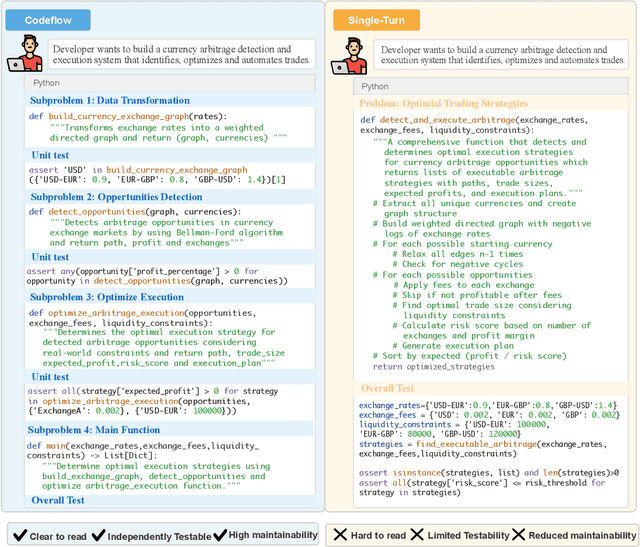
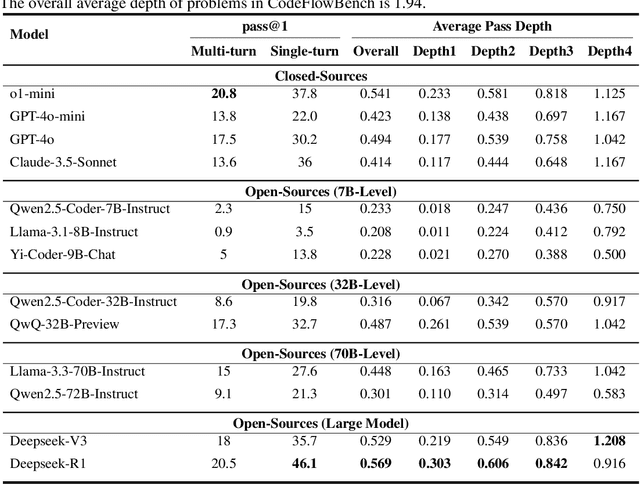
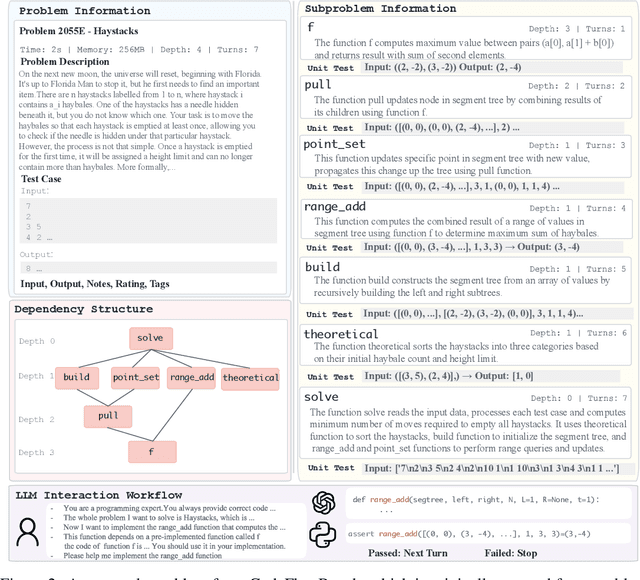

Abstract:Real world development demands code that is readable, extensible, and testable by organizing the implementation into modular components and iteratively reuse pre-implemented code. We term this iterative, multi-turn process codeflow and introduce CodeFlowBench, the first benchmark designed for comprehensively evaluating LLMs' ability to perform codeflow, namely to implement new functionality by reusing existing functions over multiple turns. CodeFlowBench comprises 5258 problems drawn from Codeforces and is continuously updated via an automated pipeline that decomposes each problem into a series of function-level subproblems based on its dependency tree and each subproblem is paired with unit tests. We further propose a novel evaluation framework with tasks and metrics tailored to multi-turn code reuse to assess model performance. In experiments across various LLMs under both multi-turn and single-turn patterns. We observe models' poor performance on CodeFlowBench, with a substantial performance drop in the iterative codeflow scenario. For instance, o1-mini achieves a pass@1 of 20.8% in multi-turn pattern versus 37.8% in single-turn pattern. Further analysis shows that different models excel at different dependency depths, yet all struggle to correctly solve structurally complex problems, highlighting challenges for current LLMs to serve as code generation tools when performing codeflow. Overall, CodeFlowBench offers a comprehensive benchmark and new insights into LLM capabilities for multi-turn, iterative code generation, guiding future advances in code generation tasks.
MaintainCoder: Maintainable Code Generation Under Dynamic Requirements
Mar 31, 2025
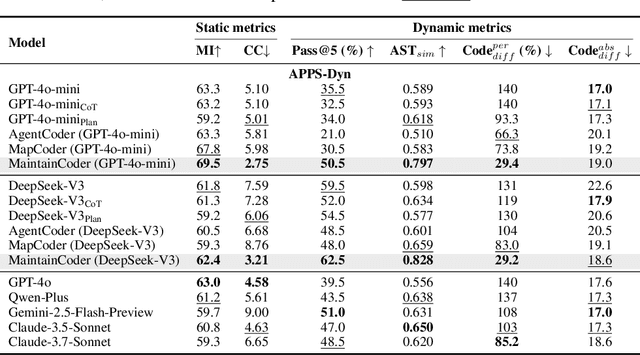
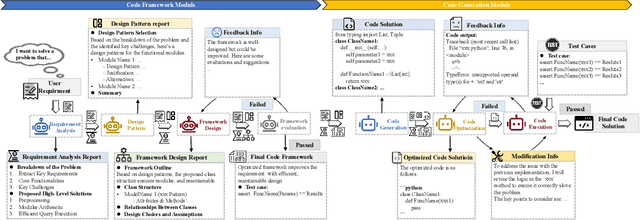
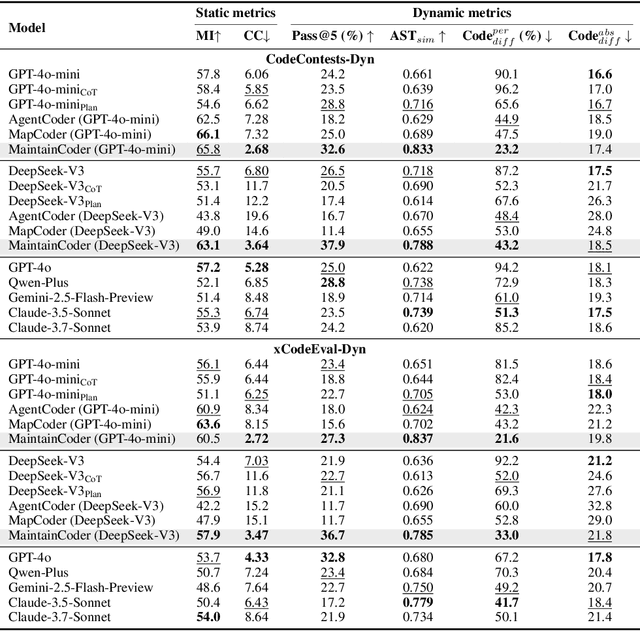
Abstract:Modern code generation has made significant strides in functional correctness and execution efficiency. However, these systems often overlook a critical dimension in real-world software development: maintainability. To handle dynamic requirements with minimal rework, we propose MaintainCoder as a pioneering solution. It integrates Waterfall model, design patterns, and multi-agent collaboration to systematically enhance cohesion, reduce coupling, and improve adaptability. We also introduce MaintainBench, a benchmark comprising requirement changes and corresponding dynamic metrics on maintainance effort. Experiments demonstrate that existing code generation methods struggle to meet maintainability standards when requirements evolve. In contrast, MaintainCoder improves maintainability metrics by 14-30% with even higher correctness, i.e. pass@k. Our work not only provides the foundation of maintainable code generation, but also highlights the need for more holistic code quality research. Resources: https://github.com/IAAR-Shanghai/MaintainCoder.
RARE: Retrieval-Augmented Reasoning Modeling
Mar 30, 2025Abstract:Domain-specific intelligence demands specialized knowledge and sophisticated reasoning for problem-solving, posing significant challenges for large language models (LLMs) that struggle with knowledge hallucination and inadequate reasoning capabilities under constrained parameter budgets. Inspired by Bloom's Taxonomy in educational theory, we propose Retrieval-Augmented Reasoning Modeling (RARE), a novel paradigm that decouples knowledge storage from reasoning optimization. RARE externalizes domain knowledge to retrievable sources and internalizes domain-specific reasoning patterns during training. Specifically, by injecting retrieved knowledge into training prompts, RARE transforms learning objectives from rote memorization to contextualized reasoning application. It enables models to bypass parameter-intensive memorization and prioritize the development of higher-order cognitive processes. Our experiments demonstrate that lightweight RARE-trained models (e.g., Llama-3.1-8B) could achieve state-of-the-art performance, surpassing retrieval-augmented GPT-4 and Deepseek-R1 distilled counterparts. RARE establishes a paradigm shift where maintainable external knowledge bases synergize with compact, reasoning-optimized models, collectively driving more scalable domain-specific intelligence. Repo: https://github.com/Open-DataFlow/RARE
HopRAG: Multi-Hop Reasoning for Logic-Aware Retrieval-Augmented Generation
Feb 18, 2025Abstract:Retrieval-Augmented Generation (RAG) systems often struggle with imperfect retrieval, as traditional retrievers focus on lexical or semantic similarity rather than logical relevance. To address this, we propose HopRAG, a novel RAG framework that augments retrieval with logical reasoning through graph-structured knowledge exploration. During indexing, HopRAG constructs a passage graph, with text chunks as vertices and logical connections established via LLM-generated pseudo-queries as edges. During retrieval, it employs a retrieve-reason-prune mechanism: starting with lexically or semantically similar passages, the system explores multi-hop neighbors guided by pseudo-queries and LLM reasoning to identify truly relevant ones. Extensive experiments demonstrate HopRAG's superiority, achieving 76.78\% higher answer accuracy and 65.07\% improved retrieval F1 score compared to conventional methods. The repository is available at https://github.com/LIU-Hao-2002/HopRAG.
A Comprehensive Survey on Imbalanced Data Learning
Feb 13, 2025Abstract:With the expansion of data availability, machine learning (ML) has achieved remarkable breakthroughs in both academia and industry. However, imbalanced data distributions are prevalent in various types of raw data and severely hinder the performance of ML by biasing the decision-making processes. To deepen the understanding of imbalanced data and facilitate the related research and applications, this survey systematically analyzing various real-world data formats and concludes existing researches for different data formats into four distinct categories: data re-balancing, feature representation, training strategy, and ensemble learning. This structured analysis help researchers comprehensively understand the pervasive nature of imbalance across diverse data format, thereby paving a clearer path toward achieving specific research goals. we provide an overview of relevant open-source libraries, spotlight current challenges, and offer novel insights aimed at fostering future advancements in this critical area of study.
MRAMG-Bench: A BeyondText Benchmark for Multimodal Retrieval-Augmented Multimodal Generation
Feb 06, 2025Abstract:Recent advancements in Retrieval-Augmented Generation (RAG) have shown remarkable performance in enhancing response accuracy and relevance by integrating external knowledge into generative models. However, existing RAG methods primarily focus on providing text-only answers, even in multimodal retrieval-augmented generation scenarios. In this work, we introduce the Multimodal Retrieval-Augmented Multimodal Generation (MRAMG) task, which aims to generate answers that combine both text and images, fully leveraging the multimodal data within a corpus. Despite the importance of this task, there is a notable absence of a comprehensive benchmark to effectively evaluate MRAMG performance. To bridge this gap, we introduce the MRAMG-Bench, a carefully curated, human-annotated dataset comprising 4,346 documents, 14,190 images, and 4,800 QA pairs, sourced from three categories: Web Data, Academic Papers, and Lifestyle. The dataset incorporates diverse difficulty levels and complex multi-image scenarios, providing a robust foundation for evaluating multimodal generation tasks. To facilitate rigorous evaluation, our MRAMG-Bench incorporates a comprehensive suite of both statistical and LLM-based metrics, enabling a thorough analysis of the performance of popular generative models in the MRAMG task. Besides, we propose an efficient multimodal answer generation framework that leverages both LLMs and MLLMs to generate multimodal responses. Our datasets are available at: https://huggingface.co/MRAMG.
Document Parsing Unveiled: Techniques, Challenges, and Prospects for Structured Information Extraction
Oct 29, 2024



Abstract:Document parsing is essential for converting unstructured and semi-structured documents-such as contracts, academic papers, and invoices-into structured, machine-readable data. Document parsing extract reliable structured data from unstructured inputs, providing huge convenience for numerous applications. Especially with recent achievements in Large Language Models, document parsing plays an indispensable role in both knowledge base construction and training data generation. This survey presents a comprehensive review of the current state of document parsing, covering key methodologies, from modular pipeline systems to end-to-end models driven by large vision-language models. Core components such as layout detection, content extraction (including text, tables, and mathematical expressions), and multi-modal data integration are examined in detail. Additionally, this paper discusses the challenges faced by modular document parsing systems and vision-language models in handling complex layouts, integrating multiple modules, and recognizing high-density text. It emphasizes the importance of developing larger and more diverse datasets and outlines future research directions.
3D Representation Methods: A Survey
Oct 09, 2024
Abstract:The field of 3D representation has experienced significant advancements, driven by the increasing demand for high-fidelity 3D models in various applications such as computer graphics, virtual reality, and autonomous systems. This review examines the development and current state of 3D representation methods, highlighting their research trajectories, innovations, strength and weakness. Key techniques such as Voxel Grid, Point Cloud, Mesh, Signed Distance Function (SDF), Neural Radiance Field (NeRF), 3D Gaussian Splatting, Tri-Plane, and Deep Marching Tetrahedra (DMTet) are reviewed. The review also introduces essential datasets that have been pivotal in advancing the field, highlighting their characteristics and impact on research progress. Finally, we explore potential research directions that hold promise for further expanding the capabilities and applications of 3D representation methods.
QAEncoder: Towards Aligned Representation Learning in Question Answering System
Sep 30, 2024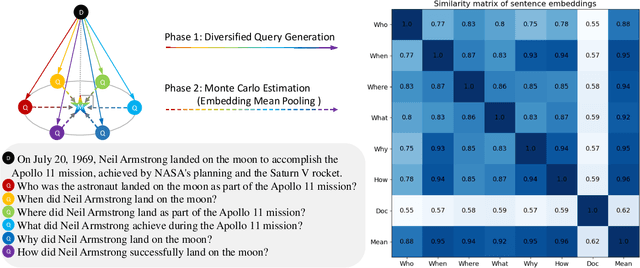
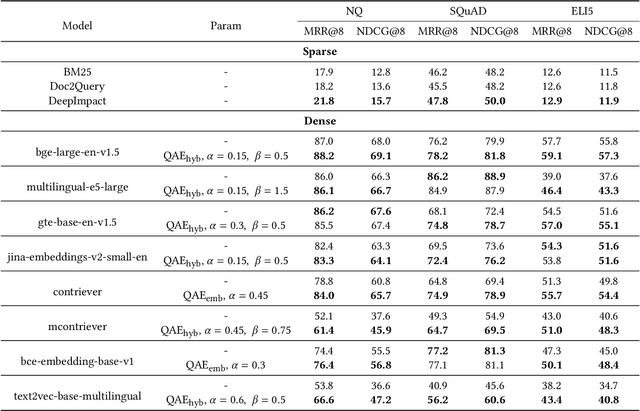
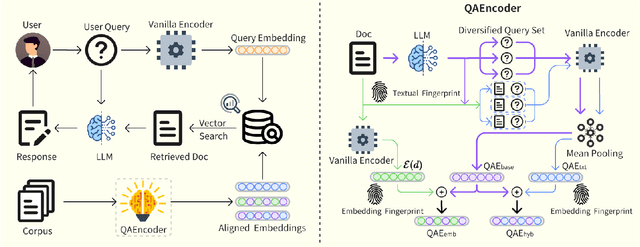
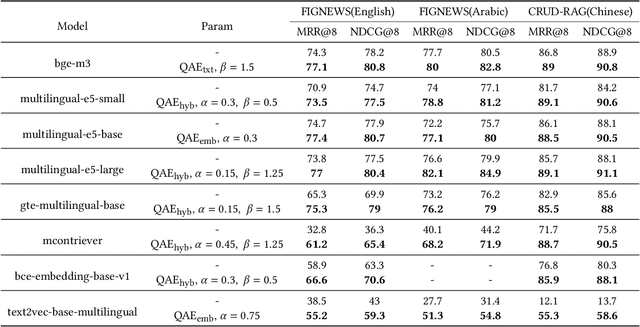
Abstract:Modern QA systems entail retrieval-augmented generation (RAG) for accurate and trustworthy responses. However, the inherent gap between user queries and relevant documents hinders precise matching. Motivated by our conical distribution hypothesis, which posits that potential queries and documents form a cone-like structure in the embedding space, we introduce QAEncoder, a training-free approach to bridge this gap. Specifically, QAEncoder estimates the expectation of potential queries in the embedding space as a robust surrogate for the document embedding, and attaches document fingerprints to effectively distinguish these embeddings. Extensive experiments on fourteen embedding models across six languages and eight datasets validate QAEncoder's alignment capability, which offers a plug-and-play solution that seamlessly integrates with existing RAG architectures and training-based methods.
Efficient Top-k s-Biplexes Search over Large Bipartite Graphs
Sep 27, 2024Abstract:In a bipartite graph, a subgraph is an $s$-biplex if each vertex of the subgraph is adjacent to all but at most $s$ vertices on the opposite set. The enumeration of $s$-biplexes from a given graph is a fundamental problem in bipartite graph analysis. However, in real-world data engineering, finding all $s$-biplexes is neither necessary nor computationally affordable. A more realistic problem is to identify some of the largest $s$-biplexes from the large input graph. We formulate the problem as the {\em top-$k$ $s$-biplex search (TBS) problem}, which aims to find the top-$k$ maximal $s$-biplexes with the most vertices, where $k$ is an input parameter. We prove that the TBS problem is NP-hard for any fixed $k\ge 1$. Then, we propose a branching algorithm, named MVBP, that breaks the simple $2^n$ enumeration algorithm. Furthermore, from a practical perspective, we investigate three techniques to improve the performance of MVBP: 2-hop decomposition, single-side bounds, and progressive search. Complexity analysis shows that the improved algorithm, named FastMVBP, has a running time $O^*(\gamma_s^{d_2})$, where $\gamma_s<2$, and $d_2$ is a parameter much smaller than the number of vertex in the sparse real-world graphs, e.g. $d_2$ is only $67$ in the AmazonRatings dataset which has more than $3$ million vertices. Finally, we conducted extensive experiments on eight real-world and synthetic datasets to demonstrate the empirical efficiency of the proposed algorithms. In particular, FastMVBP outperforms the benchmark algorithms by up to three orders of magnitude in several instances.
 Add to Chrome
Add to Chrome Add to Firefox
Add to Firefox Add to Edge
Add to Edge